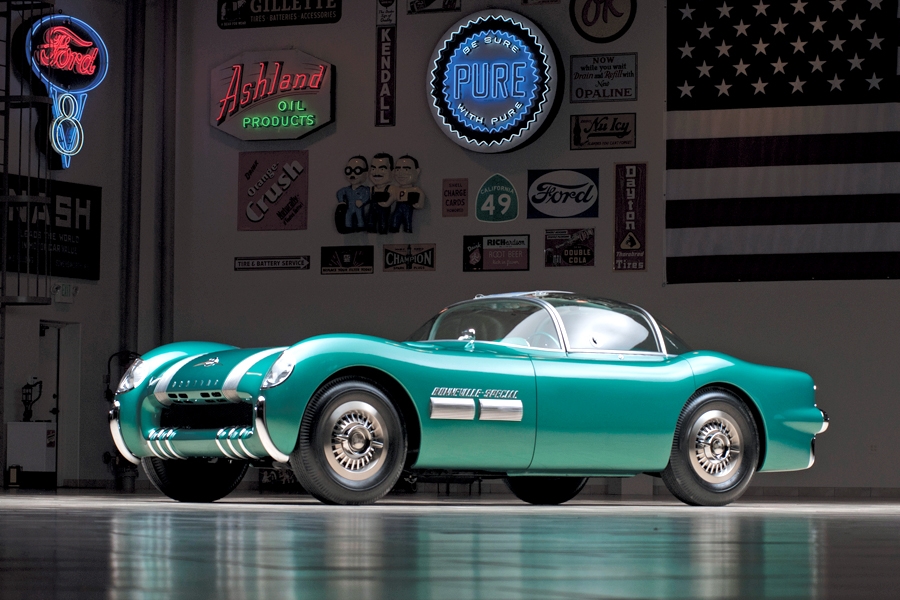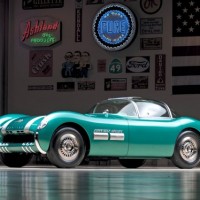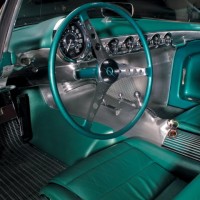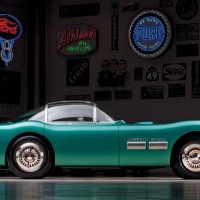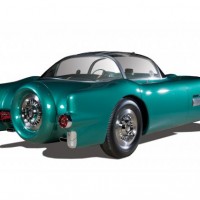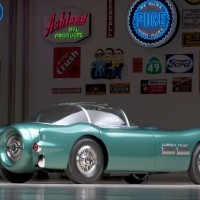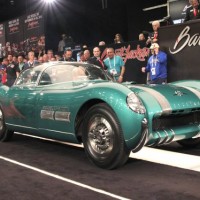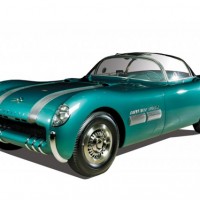SCM Analysis
Detailing
| Vehicle: | 1954 Pontiac Bonneville Special Motorama Concept Car |
| Years Produced: | 1954 |
| Number Produced: | Two |
| Original List Price: | N/A |
| SCM Valuation: | $2,500,000–$3,500,000 |
| Tune Up Cost: | $250 |
| Distributor Caps: | $50 |
| Chassis Number Location: | Tag on left front door post |
| Engine Number Location: | Raised pad on left front of cylinder block |
| Club Info: | Pontiac-Oakland Club International |
| Website: | http://www.poic.org |
| Alternatives: | 1954 Oldsmobile F-88, 1954 Chrysler GS-1 Special, 1960 Plymouth XNR Concept |
| Investment Grade: | A |
This car, Lot 2500, sold for $3,300,000, including buyer’s premium, during Barrett-Jackson’s WestWorld auction on January 10–18, 2015, in Scottsdale, AZ.
Harley Earl, General Motors Vice President of Design, put together concept — aka dream — cars to promote his vision and fantasies for the future of automobiles. They helped shaped the future of car design and tested the public’s reaction to Earl’s forward thinking. Earl’s personal car for many years was the 1938 Buick Y-Job, until it was replaced in 1951 with the LeSabre Concept car.
The Motorama, which took place between 1949 and 1961 — with a few skips — was a lavish display of dream cars that toured the country. Motorama presented one or two dream cars from each GM division with elaborate displays and Las Vegas-style entertainment. All this was supposed to give car buyers a glimpse into the future. Of course, the excitement often carried over to GM showrooms, where buyers bought what was on hand while thinking of tomorrow.
Pontiac, however, was not part of the excitement.
Paul Gillian, Pontiac’s chief designer in 1953, said: “Mr. Earl thought Pontiac was a fuddy-duddy outfit and wanted to do something for Pontiac’s racing image.”
Earl wanted a short, Le Mans-style car with a family resemblance to the Corvette. Earl insisted on the Pontiac silver streaks for brand identity — and the imitation aluminum oil coolers in the front fenders. Because of time restraints, the car builders used surplus aircraft instrumentation for gauges. The cost? An astronomical $350,000 to $400,000 in 1953 money.
What’s in this name
There are contradictory versions of how the Pontiac Bonneville Special name originated. Some say Earl dreamed it up after watching racers at the Bonneville Speed Flats, but a different, corroborated version states Earl wanted to recognize Eddie Miller, who raced on the flats with a Pontiac-powered Lakester.
Another conflict is when the second Pontiac Bonneville Special was built. One version states they were built concurrently, so that they could be displayed at both the Waldorf Astoria Motorama and in Los Angeles. The other version is from Gillian, who states, “We got a lot of publicity, which is why Pontiac built a second one about two months later and painted it green. I don’t know why they painted the second one green. That car went to dealers.”
Survival through skullduggery
There is also a conflicting story regarding the disposition of the Bonneville Specials. Michael Lamm, in his 1988 article “Where Are They Now?” states: “The second car, rumor has it, was wrecked at Pontiac’s Flint Michigan dealership and subsequently scrapped.”
We, of course, now know that rumor was only a rumor, as that second car is our subject car.
GM brass wanted Motorama Dream Cars scrapped after their tours of duty. GM officials were worried about liability issues if the cars made their way onto the public roads. Some of the cars were scrapped, some were not, and many of those survivors escaped out the back door under questionable circumstances.
Until 1959, many were stored at a GM warehouse. After that, many were sent to Warhoops Used Auto and Truck Parts in Sterling Heights, MI, where they may or may not have been destroyed.
A Pontiac engineer spirited the first Bonneville Special out the back door in 1959. The car was later sold, and it eventually ended up in the hands of noted collector Joe Bortz, with whom it remains today.
We can only speculate that our subject car — the green Bonneville Special — was salvaged in the same manner, as it also ended up in the Bortz Collection.
Riding a rising tide
We do know that Bortz offered it, in unrestored condition, at the Kruse 1998 Fall Auburn auction, where it failed to sell when bid to $300,000.
Bortz again offered it at the Barrett-Jackson January 1999 sale, and it again failed to sell when bid to $220,000. It sold shortly after that to a noted Colorado collector for an unknown amount and was subsequently restored it to its present condition.
It was then offered at the January 2006 Barrett-Jackson Auction, where Ron Pratte acquired it for $3,024,000. He displayed it in his Chandler, AZ, museum with the Motorama bus, and it made an impressive sight indeed.
It now sold for a touch more, and I have to say it was a fair transaction. The 1954 Oldsmobile F-88 concept car that Barrett-Jackson sold for $3,240,000 in the rock-concert atmosphere in 2005 set the bar, and this sale — in a far more subdued setting — was right in line. ♦
(Introductory description courtesy of Barrett-Jackson Auctions.)
